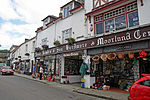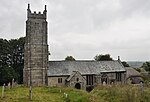Spinsters' Rock

Spinsters' Rock (grid reference SX701907) is a Neolithic dolmen near Drewsteignton in Devon. It is situated on Shilstone Farm west of the village. It is near the A382 road. The dolmen consist of three granite supports rising to between 1.7 and 2.3 metres (5 ft 7 in and 7 ft 7 in) surmounted by a capstone measuring 4.5 by 3.1 metres (15 by 10 ft). The dolmen collapsed in 1862 but was restored in the same year. No finds were recorded. There are 18th-century antiquarian reports of nearby stone circles and alignments. These reports are considered to be of "dubious accuracy". There are some free-standing stones located nearby, although only two align with Spinsters' Rock.
Excerpt from the Wikipedia article Spinsters' Rock (License: CC BY-SA 3.0, Authors, Images).Spinsters' Rock
A382, West Devon Drewsteignton
Geographical coordinates (GPS) Address External links Nearby Places Show on map
Geographical coordinates (GPS)
| Latitude | Longitude |
|---|---|
| N 50.702122 ° | E -3.8409521 ° |
Address
Spinsters' Rock (Spinsters Rock;Shilstone Cromlech)
A382
TQ13 8JP West Devon, Drewsteignton
England, United Kingdom
Open on Google Maps











